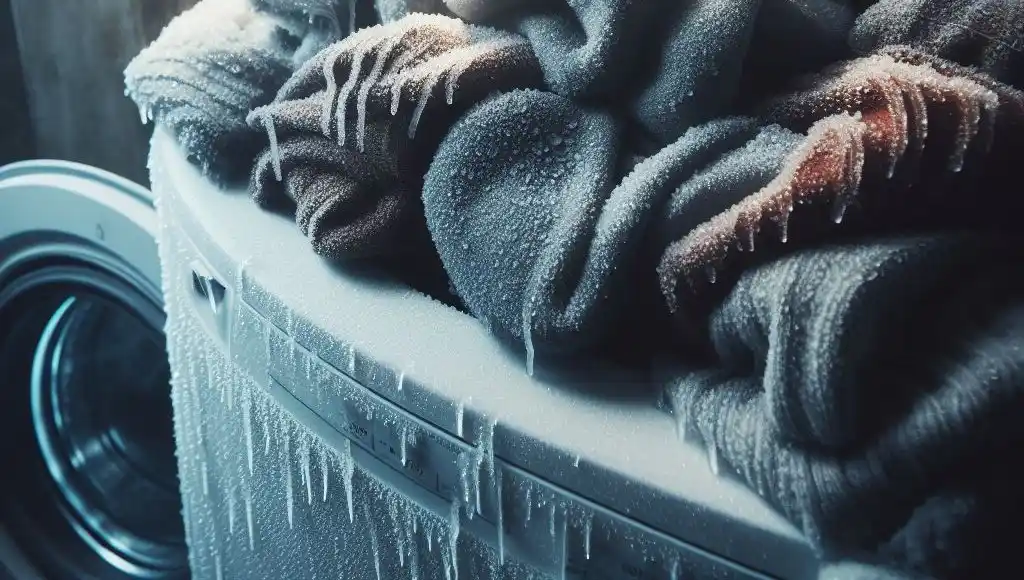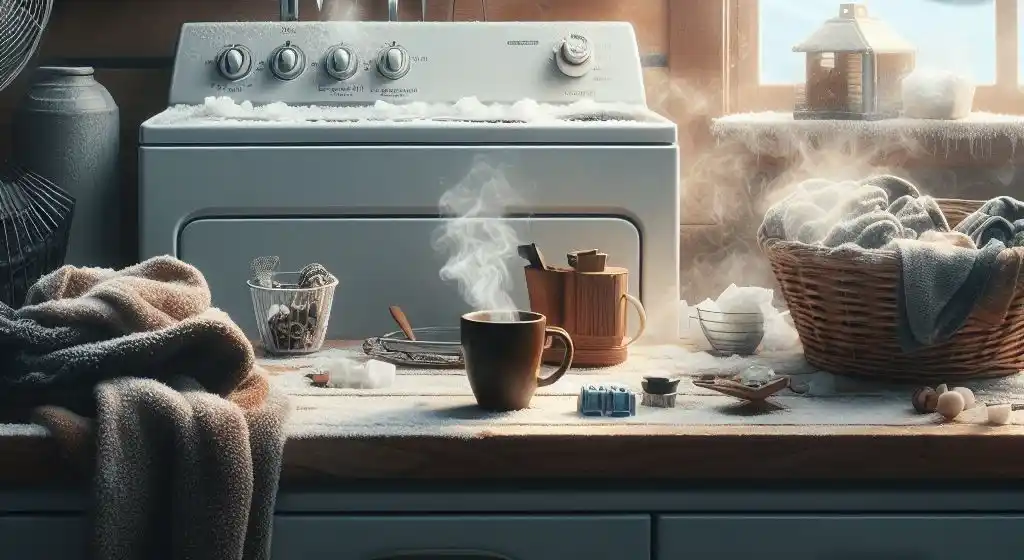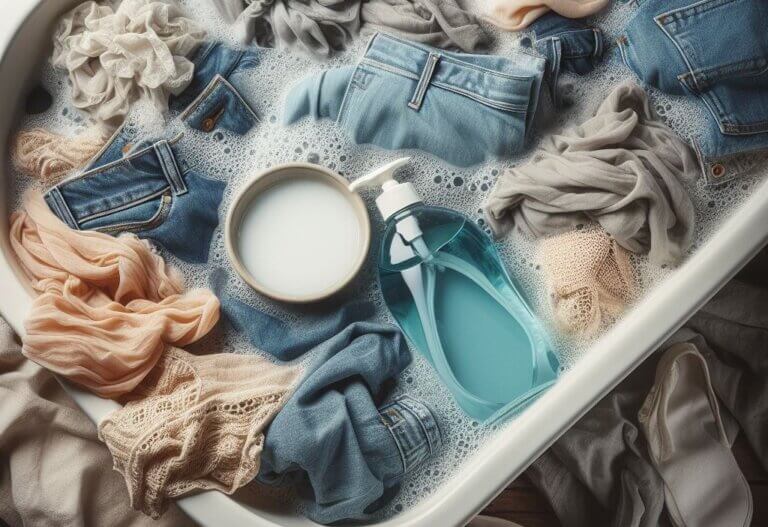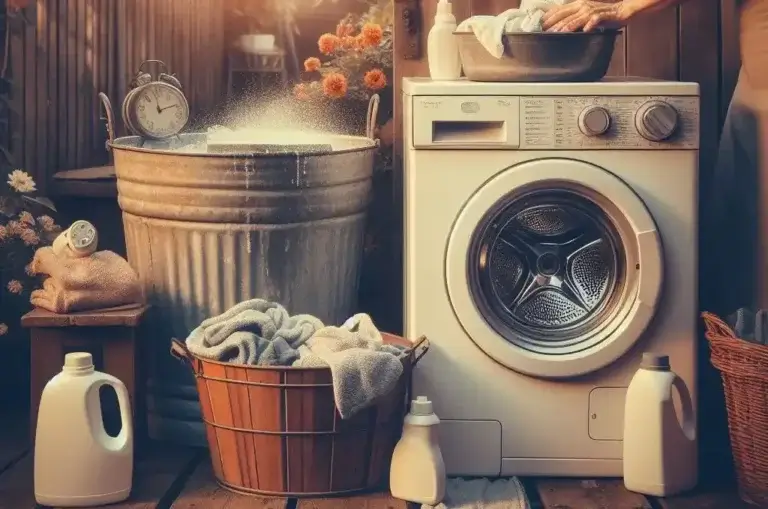Doing Laundry in Freezing Weather: How to Protect Your Appliances and Get Clothes Clean in Extreme Cold Weather
Doing laundry becomes a slippery slope when old man winter tightens his grip and the temperature drops below freezing, especially if you attempt to dry clothes outside. Freezing temperatures can wreak havoc on home appliances – causing pipes to burst, machines to malfunction, and detergents to underperform.
But never fear! With a few adjustments to your appliances, you can continue keeping those dirty loads of laundry clean all winter long, despite the freezing outside. This comprehensive guide will walk you through best practices for protecting your laundry machines, adjusting wash cycles, drying effectively, preventing damage, and troubleshooting common cold weather laundry woes. Arm yourself with the facts so you can combat winter washing machine disasters before they strike.
This comprehensive guide is about doing laundry in freezing weather including the effect of weather on washing machines, where to place washers in freezing weather, drying clothes effectively in freezing weather, and 4 Tips for Winterizing Washers & Dryers.
Table of Contents
How Does Freezing Weather Affect Washing Machines and Dryers?
Extreme cold temperatures can negatively impact water lines, valves, and internal mechanisms in washers, dryers, and other laundry appliances, making them vulnerable to cold weather. Here’s an overview of the most common cold weather issues:
- Frozen/Burst Pipes & Valves – Consistently freezing conditions cause water intake valves and connected pipes to freeze and burst. This can lead to water damage if pipes crack under pressure.
- Machine Malfunctions – Low temperatures can cause mechanical failures in washers/dryers. The water in your appliances may not fill properly or drain fully after loads of laundry are complete, possibly due to freezing outside.
- Lint Trap/Vent Issues – Ice buildup constricts airflow through dryer ductwork and lint traps. This reduces efficiency and drying ability.
- Lower Efficiency In freezing temps, heat pumps, motors, pumps, and control boards in your appliances all operate less efficiently. If it’s freezing cold outside, cycling might take longer, consume more energy, and clean/dry clothes less effectively due to less water.
- Detergent Problems – Some laundry detergents clump or get thick in cold weather. This makes measuring difficult and leads to cleaning issues.
Protecting machines from winter’s wrath takes some adjustments but doesn’t require substantial effort. A few simple preparatory steps will reduce the risk of weather-related damage.
Where to Install Washers & Dryers to Prevent Freezing Issues

Positioning laundry appliances in vulnerable areas dramatically escalates the chances of cold weather complications. Avoid installing equipment in the following locations whenever possible:
- Installing your appliances in Outdoor Areas – like your basement or garage – could expose them to freezing temps, which nearly guarantees appliances will freeze. Only use outdoor washers/dryers specifically engineered for winter conditions.
- Uninsulated Spaces – Laundry rooms, basements, garages, and pole barns without proper insulation become danger zones when temperatures plummet.
- Spaces Prone to Drafts – Any area exposed to cold air via windows, doors, cracks, or gaps represents a risk for appliance freezing.
Instead, house washing machines/dryers in interior utility rooms, heated basements, or climate-controlled mudrooms. Maintaining temperatures above 32°F gives cold-sensitive components the protection they need. Insulate spaces lacking built-in heating by weatherproofing draft sources and adding portable unit heaters if necessary.
Adjusting Washer Cycles for Maximum Efficiency
Standard wash cycles engineered for temperate conditions require tweaking, such as opting for a cold cycle to clean efficiently when temperatures are below freezing. Frigid conditions reduce water temperature and impair cleaning mechanisms for a normal cycle.
To compensate, make the following During colder weather, make necessary laundry cycle adjustments to ensure clothes get enough heat.:
- Run appliance troubleshooting cycles periodically to keep components operating optimally.
- Wash clothes on the hot water setting regardless of load size or soil level.
- Add extra rinse cycles in your appliances to combat excess detergent residue, and ensure the ice maker doesn’t freeze over in freezing temps.
- Repeat wash cycles on heavy soil or bulky loads if clothes seem damp or dirty after initial runs.
- Install a water heater near washing machines to continually pump hot water.
- Use only high-efficiency (HE) washer models designed to heat water internally during cycles.
- Upgrade to faster spin speeds to extract maximum water, reducing drying time.
- Avoid cramming washers too full – tightly packed loads take exponentially longer to get clean.
Getting familiar with your machine’s settings enables customization for maximum performance. During cold days, don’t hesitate to experiment with different cycles and options until you find the ideal winter wash formula that doesn’t let the cold weather affect your appliances.
Drying Clothes Effectively in Freezing Weather
Drying indoors is the only foolproof method for getting laundry completely dry once temperatures start dropping. But several effective (albeit slower) outdoor and supplemental drying options also exist:
Indoor Drying Strategies
Clothes dryers provide the fastest and most effective interior drying solution. However, open-air methods also work well indoors:
- Clothes Dryer – Use the high heat setting regardless of load size for the fastest drying. Check and clear lint traps frequently to maximize airflow.
- Indoor Drying Rack – Position collapsible racks near heat registers or portable space heaters. Point a fan towards the laundry to circulate warm air.
- Draped Over Furniture/Doors even when it’s cold outside – Drape freshly washed clothing over doors, furniture tops, and room dividers so air can freely circulate on both sides.
Supplemental Outdoor Drying
Attempting to air dry loads of clothes outside on a clothesline, especially during cold days, rarely works well, but the following approaches help accelerate the process and prevent ice from forming in your appliances.
- Add laundry drying racks inside covered porches, garages or enclosed patios to block wind while allowing air movement.
- Construct insulated drying cabinets with integrated fans or vents connected to your HVAC system ductwork.
- Invest in freestanding portable drying units with enclosed heating elements, hanging rods, and circulating fans.
Tip: Maintaining the desired indoor temperature during colder weather can ensure your laundry routine is not disrupted. During the night when temperatures drop, immediately remove damp/wet laundry from enclosed drying spaces to prevent ice instead of water in your appliances. Condensation forms once temperatures drop, negating your drying progress.
Last Resort Outdoor Drying
Avoid hanging clothes outdoors once the mercury dips below freezing unless necessary. While extended sunlight exposure helps dry fabric slightly, the process still takes exponentially longer than warm weather drying. If temporarily forced to dry laundry in frigid conditions:
- Hang clothes in direct sunlight whenever possible – even when cloudy.
- Layer items on multiple clotheslines to prevent overlapping or bunching and ensure efficient drying even during cold days.
- During freezing cold weather, use clamp-style hangers that grip garments firmly even in windy conditions.
- Check clothing every few hours and remove dry items immediately. Wet fabric left overnight often re-freezes.
- Drape almost-dry laundry over indoor furniture to finish overnight.
Taking a multipronged approach is the best way to dry laundry in cold weather. Utilize a combination of indoor and supplemental drying methods to get loads fully dry quickly and efficiently.
Preventing Broken Pipes & Water Damage
Consistently sub-freezing temperatures cause pipes, valves, and hose connections to crack – especially if precautions aren’t taken. Here are some winterizing tips for protecting plumbing:
Insulate Pipes & Water Lines
- Wrap washing machine hoses, water pipes, and valves near appliances with special heating tape or pipe sleeve insulation.
- In freezing temps, seal draft sources and keep laundry rooms, particularly in the basement or garage, heated to over 32° F whenever possible.
- To prevent your appliances from being vulnerable to extreme cold, completely drain washing machines after the final rinse cycle or for extended periods of disuse.
- Shut off water to washing machines when not in use and disconnect hoses.
- During cold temps, install a water sensor shut-off valve that automatically cuts the supply if a leak occurs, preventing water damage as a result.
Maintain Water Flow
- On cold enough days, run taps and laundry machines periodically to keep water moving steadily through pipes and prevent pipes from freezing.
- Keep garage doors closed and protect laundry rooms/utility sinks in unheated areas from drafts.
- Allow faucets to drip during extreme cold snaps to avoid stagnant water freezing in pipes.
Be Prepared If Pipes Freeze
- Make sure you know how to shut off the main water valve and water heater should broken pipes start leaking.
- Keep contact info handy for emergency plumbers to immediately thaw pipes if they freeze.
- Never attempt pipe repairs involving electrical components – leave to certified technicians.
Avoiding or dealing with winter water damage that can affect your appliances, especially in the basement or garage, hinges on advance preparation. Insulate vulnerable components and maintain vigilance during extremely cold snaps. Quick response, like utilizing a cold cycle, limits damage when ruptured pipes inevitably occur due to extremely cold temperatures.
4 Tips for Winterizing Washers & Dryers

Protected plumbing can still fail if washing machines and dryers aren’t properly winterized as well. Here are four key tips to avoid frozen or burst laundry appliances due to less warm water during the colder weather:
1. Install Washers Against Interior Walls
Position units against interior walls within heated spaces rather than placing them against external walls prone to drafts and freezing.
2. Insulate Dryer Vent Ductwork
Insulate your dryer exhaust tubing in areas where it gets cold; this will trap heat within the pipes to prevent condensation issues.
3. Frequently Clean Lint Traps & Vents
Check and remove accumulated lint before each load to maintain optimal airflow.
4. Disconnect Hoses During Prolonged Disuse
Removing washer hoses eliminates the chance of hose leaks or ruptures when appliances sit idle for long periods.
Troubleshooting Common Winter Laundry Problems
Despite your best prevention efforts, laundry issues still crop up when the weather turns icy. Review these troubleshooting tips addressing the most widespread cold weather washing and drying dilemmas:
Problem: running loads of laundry during extreme winter leads to water everywhere due to the expansion and contraction of pipes caused by fluctuations in temp. Any fluctuation in temp that comes with winter such as freezing cold can cause the water intake valve in appliances such as your ice maker to break. The washer won’t fill properly with water if the water intake valve breaks because of the cold outside.
Solution: frequent checks for ice instead of water in your appliances can help prevent damage related to freezing outside. Thaw frozen hoses, intake valves, and water lines. Run hot water through pipes first if necessary.
Problem: Wet laundry left in washer grows moldy
Solution: To prevent wearable items from becoming vulnerable to extreme cold, immediately remove all wet laundry after cycles finish to dry. Run appliance cleaning cycles regularly.
Problem: Clothes are still damp after the drying cycle completes, even more so if the temperature is cold outside.
Solution: Clean lint traps and vent ducts so airflow isn’t obstructed. Run extra drying cycles as needed.
Problem: Garments emerge dirty and with detergent residue
Solution: Use less detergent in winter. Add an extra rinse cycle to remove excess suds if the buildup is extreme.
Problem: Cold enough temperatures might lead to wrinkling and bunching issues with dried laundry on a clothesline.
Solution: Immediately remove, fold, and put away dried clothes as soon as cycles complete before wrinkles are set.
Don’t let the cold temps of winter win the laundry war! Follow these practical tips and best practices to keep your washers, dryers, and clothing clean despite whatever old man winter throws your way. During cold temps, maintaining proper laundry room conditions and taking preventative measures minimizes the chance of cold weather-related water damage and appliance disasters. Stay prepared and don’t let freezing temperatures stop you from checking off that never-ending chore list!
FAQs: Doing Laundry in Freezing Weather
Does laundry detergent work as effectively in cold water?
Laundry detergents contain enzymes formulated to activate in specific temperature ranges. Washing in cold slows enzyme activity, reducing cleaning performance. Using extra detergent doesn’t solve this. Instead, wash clothes in warm or hot settings regardless of detergent type.
Where should washing machines drain to avoid freezing issues?
Position washers near floor drains or sinks connected to main sewer drain lines. If draining into a wall standpipe or appliances vulnerable to cold temperatures like a laundry tub, ensure pipes contain antifreeze to avoid freeze blockages. Even in cold temps, never drain units directly onto concrete basement floors as water onto the unit can lead to long-term damage.
Is it safe to wash laundry at night in winter?
Running laundry cycles in your appliances when you’re sleeping or away from home during freezing outside, introduces risks. Appliance failures, leaks, or ruptured hoses often go unnoticed for hours, especially when temperatures are below freezing. Any fluctuation in temp that comes with winter such as cold can cause water damage as a result of improper usage of appliances. Only wash/dry loads when home, especially overnight on extremely cold nights.
Can I put off washing clothes all winter to avoid issues?
Postponing laundry for months until spring prevents winter-related disasters but causes new problems. Stockpiling dirty clothes allows mold, mildew, and bacteria to take hold. Once warm weather returns, you’ll then face a mountain of smelly, stained, and possibly ruined laundry if not use a cold cycle during extreme cold temperatures. To keep your clothes fresh and appliances protected, it’s better to regularly wash clothes all throughout winter using cold cycles and taking steps to prevent pipes from freezing.








